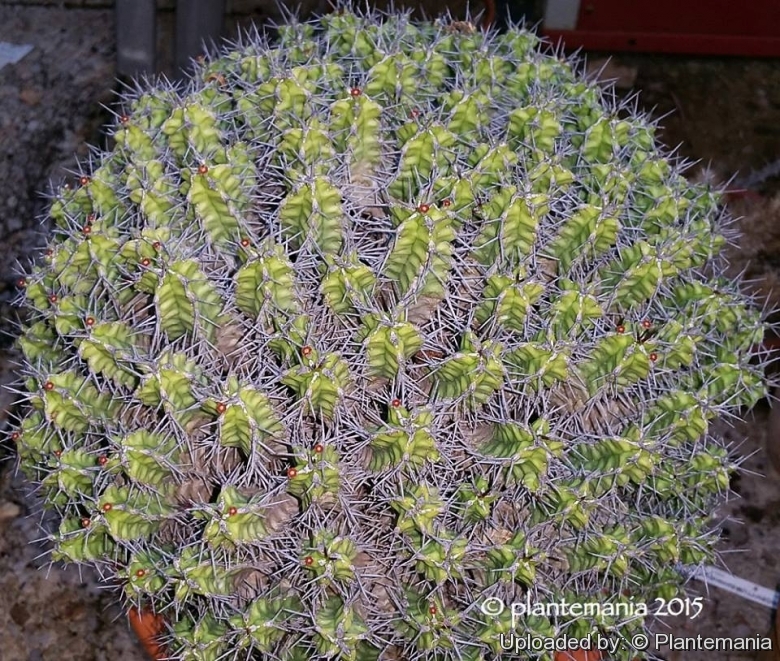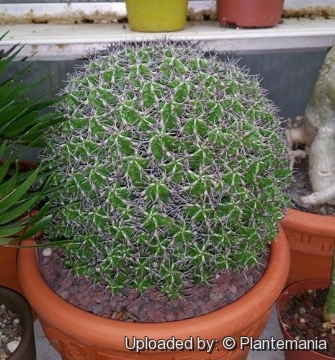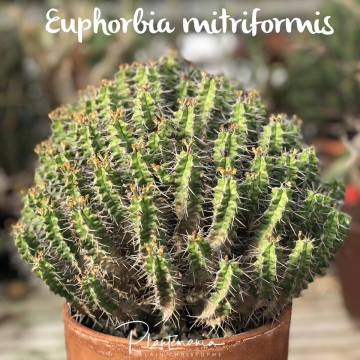




Your support is critical to our success.
Cact. Succ. J. (Los Angeles) 48(3): 128. 1976
Family: EUPHORBIACEAE

Origin and Habitat: Somalia, restricted to the eastern end of the “Al Madu” Range (Saanag region)
Altitude: 1200-1600 metres above sea level.
Habitat: Rocky, limestone slopes with very open shrubs.
Synonyms:
- Euphorbia mitriformis P.R.O.Bally & S.Carter
Euphorbia mitriformis P.R.O.Bally & S.Carter
Cact. Succ. J. (Los Angeles) 48(3): 128. 1976
Accepted name in llifle Database:
Euphorbia mitriformis Dwarf Type
Description: Euphorbia mitriformisSN|13978]]SN|13978]] is a low growing, dense, compact, clustering succulent that in nature forms impressive rounded or conical mounds up to 40(-100) cm tall and 1m wide. Each mound is composed of a lots of little heads of just 1 to 1,5 centimetres in diameter.
Remarks: Euphorbia mitriformisSN|13978]]SN|13978]] is a relatively variable species. The plants from different areas differ slightly, one from another: some form dense cushions of very small branches up to 30 cm in height; others have fewer and longer stems, up to 1 m high. The small one (a.k.a. Euphorbia mitriformisSN|13978]]SN|13978]] Dwarf Type) is the more beautiful, and appreciated in cultivation.
Stems: Branches up to 10 cm long, deeply 5-angled not exceeding 1,5 cm of width, angles with shallow teeth to 5 mm apart. The most common form in cultivation (depicted in this page) forms a globular cushion that seldom exceeds 30 cm in height.
Spines: 2-25 mm long, grey to reddish (depending on season). The basal shields of the spines are a pale greyish oblong, ± triangular 6x2 mm, irregularly angled between them, closely set apart, to form an almost continuous margin.
Flowers (Cyathia): Red on solitary cymes, 1-3 frocked up to 2,8 mm in diameter, peduncles 2 mm long. Nectar glands 1.3 mm broad, touching, brownish red. Ovary pedicellate. Styles 1 mm long, with minutely bifid apices.
Fruits (Capsules: Exserted on a recurved pedicel 4 mm long, obtusely 3-lobed, 2.5 x 2.5 mm.
Seeds: Ovoid, 1.5 x 1 mm, minutely and closely tuberculate.
Roots: Fibrous.
Subspecies, varieties, forms and cultivars of plants belonging to the Euphorbia mitriformis group
 Euphorbia mitriformis P.R.O.Bally & S.Carter: It is a relatively variable species. Some form dense cushions of very small branches up to 30 cm in height; others have fewer and longer stems, up to 1 m high.
Euphorbia mitriformis P.R.O.Bally & S.Carter: It is a relatively variable species. Some form dense cushions of very small branches up to 30 cm in height; others have fewer and longer stems, up to 1 m high. Euphorbia mitriformis Dwarf Type: form dense cushions of hundres of very small branches up to 30 cm in height and a bit wider over time. The plants are often grafted on columnar stocks to produce beautiful rounded mounds.
Euphorbia mitriformis Dwarf Type: form dense cushions of hundres of very small branches up to 30 cm in height and a bit wider over time. The plants are often grafted on columnar stocks to produce beautiful rounded mounds.
Bibliography: Major references and further lectures
1) Urs Eggli “Illustrated Handbook of Succulent Plants: Dicotyledons” Springer, 2002
2) James Cullen, Sabina G. Knees, H. Suzanne Cubey “The European Garden Flora Flowering Plants: A Manual for the Identification of Plants Cultivated in Europe, Both Out-of-Doors and Under Glass” Cambridge University Press, 11/ago/2011
3) Werner Rauh “The Wonderful World of Succulents: Cultivation and Description of Selected Succulent Plants Other Than Cacti” Smithsonian Institution Press, 1984
4) S. Carter "Flora Somalia (Euphorbia, Monadenium)" Vol 1 1993 [updated by M. Thulin 2008]

Euphorbia mitriformis Photo by: © Plantemania

Euphorbia mitriformis Photo by: © Plantemania
Cultivation and Propagation: Euphorbia mitriformisSN|13978]]SN|13978]] is an attractive, but slow growing species available from several sources for enthusiasts.
Growth rate: It is a slow growing long lived plant and once established, it will be content in its position and with its soil for years.
Soil: It grow well in a very draining mineral potting substrate but isn't picky about soil.
Watering: It can be watered moderately all year around, except in the coldest month of the winter, as it rots easily (especially if too wet). During the summer it enjoy average feeding and watering.
Exposure: It needs a lot of light to keep its compact growth-form, but different clones vary in their tolerance of full sunshine. Plants that has been growing in shade should be slowly hardened off before placing them in full sun as the plants will be severely scorched if moved too suddenly from shade into sun.
Hardiness: It is very tender; protect from frost. Recommended minimum temperature is 10 °C or even above. It responds well to warmth, in its active growth period in the late spring and summer months.
Propagation: It is propagated by cuttings or grafting. It branches enthusiastically and offsets are readily available, if you remove an offset, remember to let it dry for a week or so, letting the wound heal (cuttings planted too soon easily rot before they can grow roots). It is better to wash the cut to remove the latex.
Grafting: The plants that are grafted on a more vigorous and easier stocks are easier to keep, grow faster and produce beautiful rounded mound. The method of grafting euphorbias differs little from that of other succulents, except in one important aspect. The latex must be washed or sprayed off until hardly anything remains. After the latex flow has stopped, a further 1-2 mm slice can be taken from both surfaces without a new latex flow starting. Both scion and stock need to be at the start of the growing season. The stock should be cut as near as possible to the growing tip, as here the vascular bundles are dense and not yet woody and will feed the scion in the best possible way. Where possible stock and scion should be of similar diameter. The cut surfaces are held together with elastic bands in cross style, over the plant top and under the pot. The plants should be left in an airy and shady place for 7-10 days before the bands are removed.
Warning: As with all other Euphorbias when a plant get damaged it exudes a thick white milky sap known as latex. This latex is poisonous and may irritate skin. Pay extreme attention not to get any in your eyes or mouth.
Cultivated plants must be handled carefully.
| Your Actions | |
|---|---|
| Back to Euphorbia index | |
| Back to Euphorbiaceae index | |
 |
Back to Succulents Encyclopedia index |
Privacy stantement - Terms and conditions - How to cite - About us - Feedback - Donate



